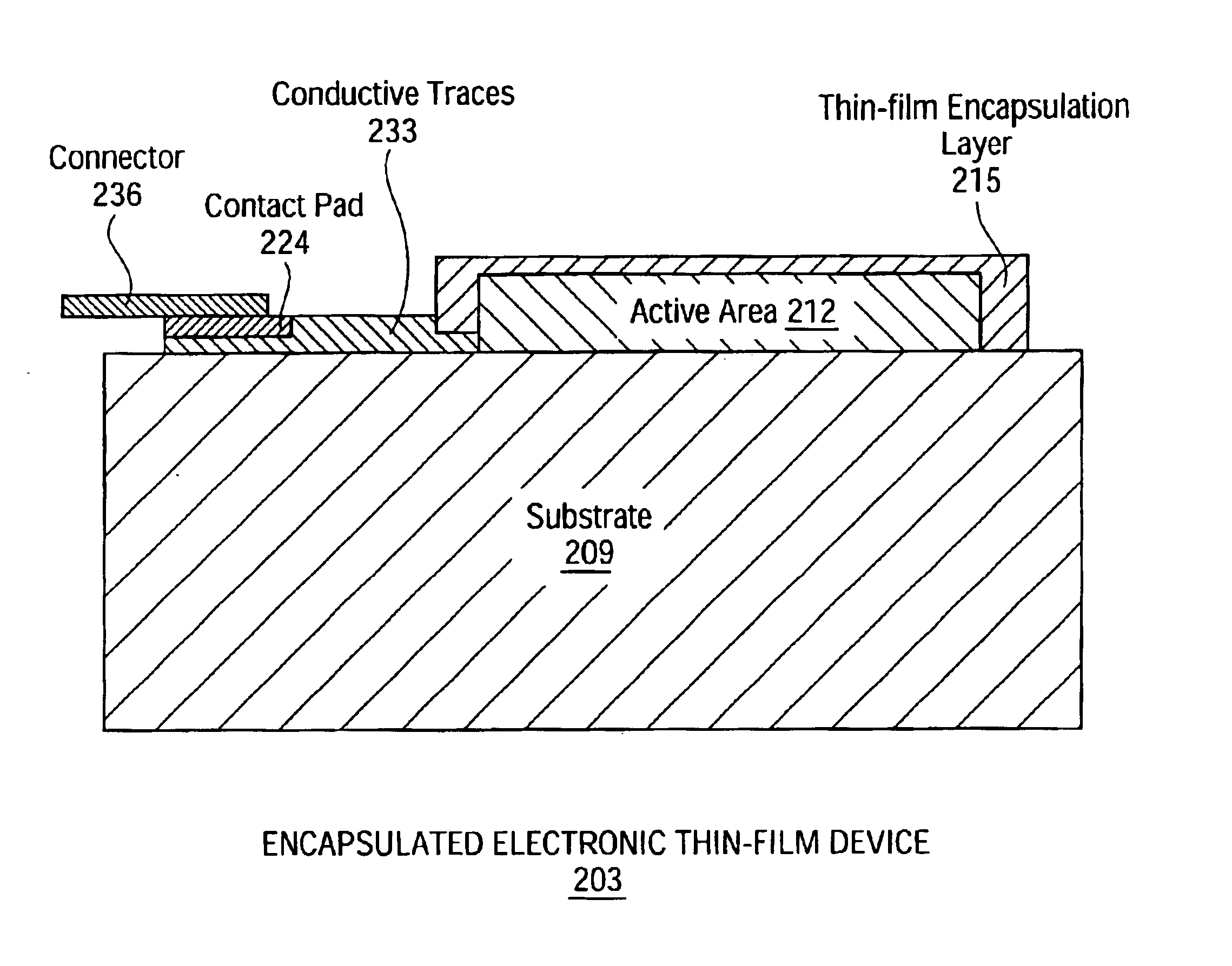Thin-film electronic device module
a technology of electronic devices and thin films, applied in the direction of photomechanical devices, instruments, radio-controlled devices, etc., can solve the problems of reducing display resolution and size, increasing resistive heating power loss in traces, and consuming less power, so as to reduce power consumption, reduce power consumption, and increase reliability
- Summary
- Abstract
- Description
- Claims
- Application Information
AI Technical Summary
Benefits of technology
Problems solved by technology
Method used
Image
Examples
first embodiment
[0026]FIG. 4 shows an encapsulated electronic thin-film device according to the present invention. An encapsulated electronic thin-film device 203 includes an active area 212 on a substrate 209. As used within the specification and the claims, the term “on” includes when there is direct physical contact between the two parts and when there is indirect contact between the two parts because they are separated by one or more intervening parts. The active area 212 is comprised of one or more electronic thin-film elements 221. The one or more electronic thin-film elements 221 is formed at the one or more intersections between the one or more row electrodes and the one or more column electrodes in which the one or more row electrodes are perpendicular to the one or more column electrodes and a semiconductive material is between those two electrodes. One end of the conductive traces 233 is coupled to the one or more row electrodes and one end of the conductive traces 230 is coupled to the ...
second embodiment
[0037]FIG. 8a shows an encapsulated electronic thin-film device according to the present invention. An encapsulated electronic thin-film device 403 includes the active area 212 on the substrate 209. The active area 212 is comprised of one or more of the electronic thin-film elements 221. The thin-film encapsulation layer 215 is selectively deposited on at least the active area 212 to cover at least the active area 212. The thickness of the thin-film encapsulation layer 215 is, for example, less than about 200 micrometers thick, preferably less than about 100 micrometers thick, more preferably less than about 50 micrometers thick. In the configuration shown in FIG. 8a, the thin-film encapsulation layer 215 extends slightly past the perimeter of the active area 212. The range of this slight extension is, for example, from about 10 um to about 10 mm, and preferably from about 0.5 mm to about 3 mm. In another configuration (not shown), the thin-film encapsulation layer 215 may only cove...
fourth embodiment
[0038]FIG. 8b shows a connector according to the present invention. In this embodiment, a connector 440 includes connector traces 443, connector traces 446, and connector traces 449. The connector traces 443 are coupled to the contact pad 415, the connector traces 446 are coupled to the contact pad 421, and the connector traces 449 are coupled to the contact pad 427. Here, the connector 440 covers all of the active area 212. In one configuration of this embodiment, each of the row electrodes of the active area 212 is coupled to a particular one of the conductive traces 412 and also a particular one of the conductive traces 424 and thus to the contact pad 415 and the contact pad 427 respectively. Coupling each of the row electrodes to both the contact pads reduces the voltage drops along the rows inside the active area 212. In another configuration, the conductive traces 412 and the conductive traces 424 are each coupled to only half of the row electrodes. For example, the conductive...
PUM
 Login to view more
Login to view more Abstract
Description
Claims
Application Information
 Login to view more
Login to view more - R&D Engineer
- R&D Manager
- IP Professional
- Industry Leading Data Capabilities
- Powerful AI technology
- Patent DNA Extraction
Browse by: Latest US Patents, China's latest patents, Technical Efficacy Thesaurus, Application Domain, Technology Topic.
© 2024 PatSnap. All rights reserved.Legal|Privacy policy|Modern Slavery Act Transparency Statement|Sitemap



